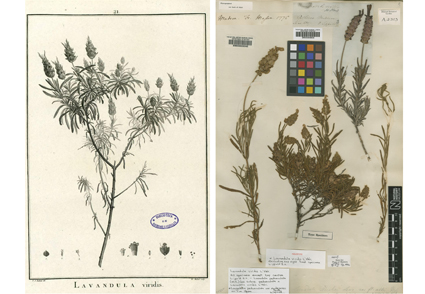Abstract
The typification of the name Lavandula viridis (Labiatae) is revised. A “holotype” had previously been indicated by Upson and Andrews in 2004 from a specimen kept at the herbarium BM. However, the original material comprises more than one element. Therefore, a lectotype for this name is designated in this work according to the International Code of Nomenclature for algae, fungi, and plants (Shenzhen Code of 2018). The name is lectotypified using a specimen preserved at BM and collected by Francis Masson in Madeira in 1776.
References
- Aiton, W. (1789) Hortus kewensis, or, a catalogue of the plants cultivated in the Royal Botanic Garden at Kew by William Aiton Gardener to his Majesty. Vol. I. George Nicol, London, 547 pp. https://doi.org/10.5962/bhl.title.4504
- Bentham, G. (1848) Labiatae. In: Candolle, A.L.P.P. de (ed.) Prodromus systematis naturalis regni vegetabilis, vol. 12. Masson, Paris, pp. 27−603.
- Britten, J. (1912) The history of Aiton’s “Hortus Kewensis”. Journal of Botany 50 (Suppl. 3): 1–16. [https://www.biodiversitylibrary.org/item/111655#page/598/mode/1up]
- Carter, H.B. (1988) Sir Joseph Banks 1743–1820. British Museum (Natural History), London, 671 pp.
- Cavanilles, A.J. (1801) De las plantas que el ciudadano Augusto Broussonet colectó en las costas septentrionales de la África y en las Islas Canarias. Anales de Ciencias Naturales 3: 5–78.
- Chaytor, D. (1937) A taxonomic study of the genus Lavandula L. The Journal of the Linnean Society. Botany 51: 153–204. https://doi.org/10.1111/j.1095-8339.1937.tb01906.x
- Gingins de la Sarraz, F.-C.-J. (1826) Histoire naturelle des lavandes. Geneva, Paris, 188 pp. + 11 tab.
- Guinea, E. (1972) Lavandula L. In: Tutin, T.G., Heywood, V.H., Burges, N.A., Moore, D.M., Valentine, D.H., Walters, S.M. & Webb, D.A. (eds.) Flora Europea. Vol. 3. Cambridge University Press, Cambridge, pp. 187–188.
- Jocou, A.I. (2021) (070) Proposal to add a new Example after Article 9 Note 6 to illustrate when the term “holotype” cannot be corrected. Taxon 70: 453–453. https://doi.org/10.1002/tax.12469
- Jussieu, A.L. (1789) Genera plantarum. Herissant, Paris, 498 pp.
- Krok, T.O.B.N. (1925) Bibliotheca botanica suecana. Almqvist & Wiksell, Uppsala & Stockholm, 799 pp.
- L’Héritier, C.-L. (1789–1792) Sertum anglicum seu plantae rariores quae in hortis juxta Londinum, imprimis in horto regio Kewensi excoluntur, ab anno 1786 ad annum 1787 observatae. P.F. Didot, Paris, 36 pp. + 34 tab. [4 fasc., between 1789 y 1792 [cf. F.A. Stafleu & R.S. Cowan, “Taxonomic literature” ed. 2, n.º 4.492]; the date on the cover is 1788: Fasc. 1, pp. [i–iv], 1–36, tab. 1–2 (princ. I.1789) Fasc. 2, tab. 3–12 (V.1790) Fasc. 3, tab. 13–24, 15bis (IV.1792) Fasc. 4, tab. 25–34 (fin. 1792)].
- Linnaeus, C. (1753) Species plantarum. Salvius, Stockholm, 1200 pp.
- López-González, G. (2001) Los árboles y arbustos de la Península Ibérica e Islas Baleares. Ediciones Mundi-Prensa, Madrid-Barcelona-México, 1727 pp.
- McNeill, J. (2014) Holotype specimens and type citations: General issues. Taxon 63: 1112–1113. https://doi.org/10.12705/635.7
- Masson, F. (1796) Stapeliæ novæ: or, a collection of several new species of that genus; discovered in the interior parts of Africa. W. Bulmer and Co. for George Nicol, London, 24 pp. + 41 tab. https://doi.org/10.5962/bhl.title.102996
- McNaughton, V. (2002) Lavender, the grower’s guide. Garden Art Press, Australia, 180 pp.
- Morales, R. (2010) Lavandula L. In: Morales, R., Quintanar, A., Cabezas, F., Pujadas, A.J. & Cirujano, S. (eds.) Flora iberica, vol. 12. Real Jardín Botánico, CSIC. Madrid, pp. 484–496.
- Prado, J., Hirai, R.Y. & Moran, R.C. (2015) (046–048) Proposals concerning inadvertent lectotypifications (and neotypifications). Taxon 64: 651. https://doi.org/10.12705/643.29
- Rozeira, A. (1949) A Secçao Stoechas Ging. do genero Lavandula L. Broteria 18: 1–82.
- Rozeira, A. (1964) As subspecies portuguesas de Lavandula stoechas L. Agronomia Lusitanica 24: 172–173.
- Ruiz de la Torre, J. (2006) Flora Mayor. Organismo Autónomo de Parques Nacionales, Dirección General para la Biodiversidad, Madrid, 1756 pp.
- Salgueiro, F.J. (1998) Estudio sobre los herbarios históricos de la Universidad de Sevilla. Universidad de Sevilla, Sevilla, 778 pp + CXCI pp. [https://idus.us.es/handle/11441/15604]
- Silva, A.R.P. da & Fontes, F. (1951) Plantas raras e plantas novas para o Algarve. Agronomia Lusitanica 13: 77–87.
- Stafleu, F.A. & Cowan, R.S. (1976) Taxonomic Literature. Ed. 2. Vol. 1. Bohn, Scheltema & Holkema, Utrecht, 1136 pp.
- Stafleu, F.A. & Cowan, R.S. (1981) Taxonomic Literature. Ed. 2. Vol. 3. Bohn, Scheltema & Holkema, Utrecht, 980 pp.
- Stearn, W.T. (1972) Philip Miller and the plants from the Chelsea Physic Garden presented to the Royal Society of London, 1723–1796. Transactions of the Botanical Society of Edinburgh 41: 293–307. https://doi.org/10.1080/03746607208685233
- Suárez-Cervera, M. & Seoane-Camba, J.A. (1986) Taxonomía numérica de algunas especies de Lavandula L., basada en carácteres morfológicos, cariológicos y palinológicos. Anales del Jardín Botánico de Madrid 42: 395–409.
- Turland, N.J., Wiersema, J.H., Barrie, F.R., Greuter, W., Hawksworth, D.L., Herendeen, P.S., Knapp, S., Kusber, W.-H., Li, D.-Z., Marhold, K., May, T.W., McNeill, J., Monro, A.M., Prado, J., Price, M.J. & Smith, G.F. (eds.) (2018) International Code of Nomenclature for algae, fungi, and plants (Shenzhen Code) adopted by the Nineteenth International Botanical Congress Shenzhen, China, July 2017. Regnum Vegetabile 159. Glashütten: Koeltz Botanical Books. https://doi.org/10.12705/Code.2018
- Upson, T.M. & Andrews, S. (2004) The genus Lavandula. Timber press, Oregon, 442 pp.
- Van Oost, E., Leus, L., De Rybel, B. & Van Laere, K. (2021) Determination of genetic distance, genome size and chromosome numbers to support breeding in ornamental Lavandula species. Agronomy 11: 2173. https://doi.org/10.3390/agronomy11112173
- Vázquez, F.M., Márquez, F., García, D. & Nogales, L. (2022) Aproximación al conocimiento del género Lavandula L. Sección Stoechas Ging., (Laminaceae) en el SW de la Península Ibérica. Folia Botanica Extremadurensis 16: 55–94.


